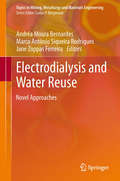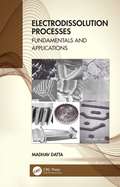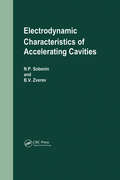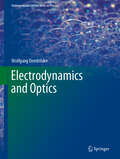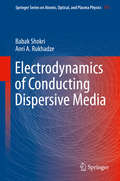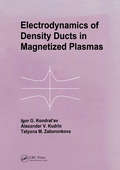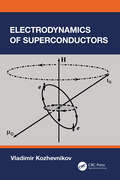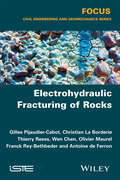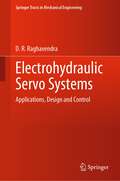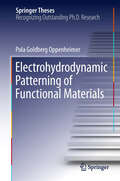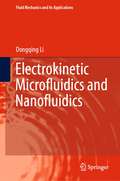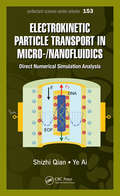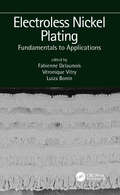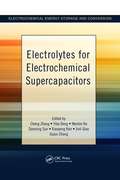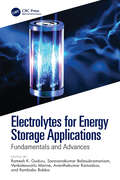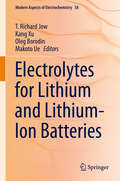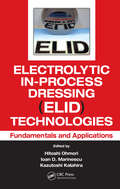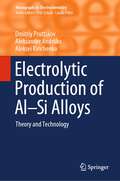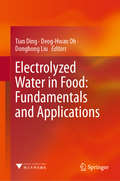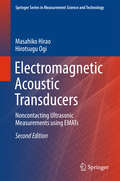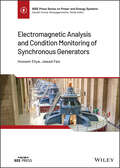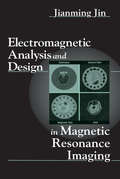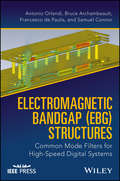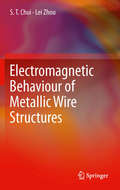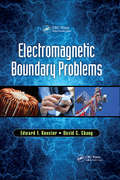- Table View
- List View
Electrodialysis and Water Reuse
by Andréa Moura Bernardes Marco Antônio Siqueira Rodrigues Jane Zoppas FerreiraThis book presents novel techniques to evaluate electrodialysis processes, to synthesize ionic membranes and to characterize their properties. It shows the potential use of membrane process to the treatment of effluents generated in many industrial sectors such as refineries, leather industries, mining and electroplating processes. The book is based on the results obtained by the author's research group during the past decade. It is useful for students, researchers and engineers interested in membrane technologies for water reuse.
Electrodissolution Processes: Fundamentals and Applications
by Madhav DattaElectrodissolution Processes: Fundamentals and Applications discusses the basic principles involved in high-rate anodic dissolution processes and their application in advanced machining, micromachining, and finishing operations. The fundamentals section of the book discusses the anodic dissolution behavior of different classes of metals and the influence of mass transport, current distribution, and surface film properties on the metal removal rate and surface finishing. The applications section of the book presents essential elements of electrochemical and assisted techniques for precision machining, micromachining, and polishing of advanced materials, including hard-to-machine conducting ceramic materials. Features A first-of-its-kind book that provides updated scientific and engineering information related to high-rate anodic dissolution processes Highlights the importance of the understanding of basic principles required for designing and optimizing ECM/EMM/EP processes Gives equal emphasis to the fundamentals and applications of electrodissolution processes Discusses the high-rate anodic dissolution of two broad classes of materials, namely, engineering and refractory materials Presents case studies to demonstrate the capabilities of different electrochemical and assisted machining, micromachining, and finishing operations Presents a dedicated chapter on electrochemical planarization of copper interconnects Madhav Datta is the Chairman of Amrita Center for Industrial Research and Innovation and a Distinguished Professor in the Department of Chemical Engineering and Materials Science, Amrita University, Coimbatore, India.
Electrodynamic Characteristics of Accelerating Cavities
by N P Sobenin B V ZverevNow available for the first time in English translation, this important book contains extensive material relating to the electrodynamic characteristics of linear accelerators, and gives a good overview of the fundamentals of accelerating cavity design. The authors describe the experimental methods and measurement techniques essential in this area of research, and provide comprehensive data about the electrodynamic characteristics of resonant structures, which are widely used in charged particle accelerators and microwave devices. Single cavities and coupling chains, excited in electrical and magnetic modes, are described numerically and analyzed in detail. The book also provides a valuable description of the perturbation method, which is illustrated using a unique collection of data.
Electrodynamics and Optics (Undergraduate Lecture Notes in Physics)
by Wolfgang DemtröderThis engaging text offers an accessible and clear treatment of the fundamentals of electromagnetics and optics, a core part of the standard undergraduate physics curriculum. Starting with static electric and magnetic fields, the book works through electromagnetic oscillations and the formation and propagation of electromagnetic waves, before moving on to geometric and wave optics, optical instrumentation and some discussion of new technologies in optics. The text is written from the experimental physics point of view, giving numerous real life examples and applications of devices. This highly motivating presentation deepens the knowledge in a very accessible way, carefully interweaving theory and practical applications. Students are guided through the material with well-chosen examples and case studies, and helpful chapter summaries are provided together with numerous exercises and detailed solutions, all intended to motivate and develop a well-founded understanding of the subject matter.
Electrodynamics of Conducting Dispersive Media (Springer Series on Atomic, Optical, and Plasma Physics #111)
by Babak Shokri Anri A. RukhadzeThis book presents a sequential representation of the electrodynamics of conducting media with dispersion. In addition to the general electrodynamic formalism, specific media such as classical nondegenerate plasma, degenerate metal plasma, magnetoactive anisotropic plasma, atomic hydrogen gas, semiconductors, and molecular crystals are considered.The book draws on such classics as Electrodynamics of plasma and plasma-like media (Silin and Rukhadze) and Principles of Plasma Electrodynamics (Alexandrov, Bogdankevich, and Rukhadze), yet its outlook is thoroughly modern—both in content and presentation, including both classical and quantum approaches. It explores such recent topics as surface waves on thin layers of plasma and non-dispersive media, the permittivity of a monatomic gas with spatial dispersion, and current-driven instabilities in plasma, among many others. Each chapter is equipped with a large number of problems with solutions that have academic and practical importance. This book will appeal to graduate students as well as researchers and other professionals due to its straight-forward yet thorough treatment of electrodynamics in conducting dispersive media.
Electrodynamics of Density Ducts in Magnetized Plasmas: The Mathematical Theory of Excitation and Propagation of Electromagnetic Waves in Plasma Waveguides
by I G Kondratiev A V Kudrin T M ZaboronkovaProviding a systematic and self-contained treatment of excitation, propagation and re- emission of electromagnetic waves guided by density ducts in magnetized plasmas, this book describes in detail the theoretical basis of the electrodynamics of ducts. The classical dielectric-waveguide theory in open guiding systems in magnetoplasma is subjected to rigorous generalization. The authors emphasize the conceptual physical and mathematical aspects of the theory, while demonstrating its applications to problems encountered in actual practice. The opening chapters of the book discuss the underlying physical phenomena, outline some of the results obtained in natural and artificial density ducts, and describe the basic theory crucial to understanding the remainder of the book. The more specialized and complex topics dealt with in subsequent chapters include the theory of guided wave propagation along axially uniform ducts, finding the field excited by the source in the presence of a duct, excitation of guided modes, the asymptotic theory of wave propagation along axially nonuniform ducts, and mode re-emission from a duct. The full wave theory is used throughout most of the book to ensure consistency, and the authors start with simpler cases and gradually increase the complexity of the treatment.
Electrodynamics of Superconductors
by Vladimir KozhevnikovSuperconductivity is a remarkable, on the verge of miraculous, macroscopic quantum phenomenon with a boundless potential for a wide variety of applications. Over the last century the physics of superconductivity constitutes a major part of research in condensed matter and yet the electrodynamics of superconductors appears as only a minor part in textbooks on electrodynamics and superconductivity. The book offers a fresh look at electrodynamics of continuous media with detailed description of thermal and electromagnetic properties of superconductors, emphasising physical meaning of concepts and principles without excessive mathematics. To facilitate understanding, it is accompanied by problems and worked solutions. The book will be of interest to senior undergraduate and graduate students of physics and chemistry who have taken a calculus-based course in general physics. It is a valuable reference for researchers involved in studies of superconductivity, the physics of metals, and condensed matter physics.Key Features: The first book - in terms of semi-classical physics - addressing both equilibrium and nonequilibrium, thermal and transport properties of superconducting materials Presents an accessible overview without excessive mathematics Accompanied by problems with solutions to aid understanding
Electrohydraulic Fracturing of Rocks
by Gilles Pijaudier-Cabot Olivier Maurel Wen Chen Thierry Reess Antoine De Ferron Christian La Borderie Franck Rey-BerbederThis book presents a new fracturing technique that should be considered as a potential alternative, or a companion technique, to hydraulic fracturing of tight gas reservoirs and low permeability rock masses. As opposed to hydraulic fracturing which generates a few numbers of large cracks, electro-hydraulic fracturing induces diffuse micro-cracking and fragmentation of rocks. Laboratory tests demonstrate that increases of permeability by two orders of magnitude can be reached, without major cracking in tested specimens. This book discusses the principles of this new technique, reports experiments which have been developed is order to prove the concept and finally describes the numerical model from which the potentialities of this technique in representative reservoir conditions can be assessed.
Electrohydraulic Servo Systems: Applications, Design and Control (Springer Tracts in Mechanical Engineering)
by D. R. RaghavendraThis book covers the fundamental concepts of electrohydraulic (EH) servo systems in detail and also presents the developments about power, quadratic response, and control flexibility of EH servo systems with applications in aircraft/aerospace engineering, mobile equipment, material/structure testing, motion simulators, and strategic defense sectors. Various topics covered in this books are systems and configurations of servo systems, components, applications, design of SISO and MIMO and control options of SISO and MIMO systems. It further includes a chapter on contamination control, fault detection and diagnosis (FDD) of these systems. The detailed working procedures and advice on implementation routines presented in this book will help readers to apply the control models and systems presented so as to make their own servo systems more efficient. The book will be useful for mechanical engineers and professionals involved in the analysis and design of electrohydraulic control systems, especially in advanced hydraulic industries, the aeronautical and space, and automotive industries. It would also be a useful reference for advanced courses in EH systems.
Electrohydrodynamic Patterning of Functional Materials
by Pola Goldberg OppenheimerThis thesis explores a route to induce and control the structure formation process in thin films by the use of strong electric fields. We investigate, establish and apply the use of the electrohydrodynamic (EHD) lithography as a versatile patterning tool on the sub-micrometre and nanometre length scales for functional materials. Thin films are ubiquitous, they are found in nature and used in almost every aspect of daily life. While film instabilities are often undesirable in nature and technology, they can be utilized to produce structures by precisely controlling the destabilization of the film. EHD lithography utilizes instabilities induced by means of an electric field to fabricate periodic structures. EHD patterning is set to become a competitive candidate for low-cost lithographic technology for a number of applications. Herein, the applied potential of this lithographic process is explored by expanding its applicability to a broad range of materials and by a simultaneous patterning of multilayer systems or functional polymers yielding hierarchical architectures with novel functionalities. EHD pattern formation enables for instance, the fabrication of multi-scale structured arrays as surface enhanced Raman scattering (SERS)-active platforms. Furthermore, crystalline and conductive polymers are patterned using the EHD approach and the underlying structure formation mechanisms are discussed. This extension towards functional material systems offers interesting prospects for potential applications. Findings of this thesis are very promising for use in optoelectronic devices.
Electrokinetic Microfluidics and Nanofluidics (Fluid Mechanics and Its Applications #133)
by Dongqing LiThis book reviews the latest advancement of microfluidics and nanofluidics with a focus on electrokinetic phenomena in microfluidics and nanofluidics. It provides fundamental understanding of several new interfacial electrokinetic phenomena in microfluidics and nanofluidics. Chapter 1 gives a brief review of the fundamentals of interfacial electrokinetics. Chapter 2 shows induced charge electrokinetic transport phenomena. Chapter 3 presents the new advancement in DC dielectrophoresis. Chapter 4 introduces a novel nanofabrication method and the systematic studies of electrokinetic nanofluidics. Chapter 5 presents electrokinetic phenomena associated with Janus particles and Janus droplets. Chapter 6 introduces a new direction of electrokinetic nanofluidics: nanofluidic iontronics. Chapter 7 discusses an important differential resistive pulse sensor in microfluidics and nanofluidics.
Electrokinetic Particle Transport in Micro-/Nanofluidics: Direct Numerical Simulation Analysis (Surfactant Science)
by Shizhi Qian Ye AiNumerous applications of micro-/nanofluidics are related to particle transport in micro-/nanoscale channels, and electrokinetics has proved to be one of the most promising tools to manipulate particles in micro/nanofluidics. Therefore, a comprehensive understanding of electrokinetic particle transport in micro-/nanoscale channels is crucial to the
Electroless Nickel Plating: Fundamentals to Applications
by Fabienne Delaunois Veronique Vitry Luiza BoninElectroless Nickel Plating: Fundamentals to Applications provides a complete and actualized view of electroless nickel plating, thus greatly improving the accessibility of knowledge on the subject. It touches upon all aspects of electroless nickel, from the fundamentals (including thermodynamics of electroless plating, bath chemistry, and substrate preparation) to more applied areas of the field such as bath replenishment, composite coatings, post-treatments, polyalloys, graded and multilayer coatings, ultrasound assistance, applications, and properties. Contributed to by a variety of international authors to ensure different points of view and interests are addressed, this book stands as the first complete and updated state-of-the-art text on electroless nickel in the twenty-first century. It also serves as the first technical book with a strong emphasis on nickel-boron. It also focuses on environmental aspects. Including cutting-edge content presented sufficiently extensive to be directly useful to the practitioner, this book is aimed at materials scientists, metallurgists, and other professionals working with electroless nickel plating.
Electrolytes for Electrochemical Supercapacitors (Electrochemical Energy Storage and Conversion)
by Jiujun Zhang Jinli Qiao Cheng Zhong Yida Deng Wenbin Hu Daoming Sun Xiaopeng HanElectrolytes for Electrochemical Supercapacitors provides a state-of-the-art overview of the research and development of novel electrolytes and electrolyte configurations and systems to increase the energy density of electrochemical supercapacitors. Comprised of chapters written by leading international scientists active in supercapacitor research
Electrolytes for Energy Storage Applications: Fundamentals and Advances
by Ramesh K. Guduru Saravanakumar Balasubramaniam Venkateswarlu Manne Ananthakumar Ramadoss Rambabu BobbaThe book offers detailed progress and challenges in energy storage technologies with respect to various electrolyte chemistries including energy storage devices such as batteries and supercapacitors. It introduces energy storage systems and explains the selection of electrolytes for energy storage systems, aqueous- and non-aqueous-based electrolytes, metal-air batteries, and multivalent chemistries. Key features: Provides a better understanding of electrolytes for electrochemical energy storage devices Focuses on electrolytes and electrolytes valence Presents challenges and opportunities in energy storage systems Explains supercapacitors with respect to electrolyte systems Summarizes multivalent-based energy storage systems This book is written for graduate students and researchers in electrochemistry, physical chemistry, and renewable energy.
Electrolytes for Lithium and Lithium-Ion Batteries
by T. Richard Jow Kang Xu Oleg Borodin Makoto UeElectrolytes for Lithium and Lithium-ion Batteries provides a comprehensive overview of the scientific understanding and technological development of electrolyte materials in the last several years. This book covers key electrolytes such as LiPF6 salt in mixed-carbonate solvents with additives for the state-of-the-art Li-ion batteries as well as new electrolyte materials developed recently that lay the foundation for future advances This book also reviews the characterization of electrolyte materials for their transport properties, structures, phase relationships, stabilities, and impurities. The book discusses in-depth the electrode-electrolyte interactions and interphasial chemistries that are key for the successful use of the electrolyte in practical devices. The Quantum Mechanical and Molecular Dynamical calculations that has proved to be so powerful in understanding and predicating behavior and properties of materials is also reviewed in this book. Electrolytes for Lithium and Lithium-ion Batteries is ideal for electrochemists, engineers, researchers interested in energy science and technology, material scientists, and physicists working on energy.
Electrolytic In-Process Dressing (ELID) Technologies: Fundamentals and Applications
by Ioan D. Marinescu Hitoshi Ohmori Kazutoshi KatahiraEdited by experts, one of whom developed the technology, Electrolytic In-Process Dressing (ELID) Technologies: Fundamentals and Applications provides an overview of ELID processes with correlations between the main parameters, describes ELID operations, and illustrates the concepts with case studies. The book's authoritative coverage of major conce
Electrolytic Production of Al–Si Alloys: Theory and Technology (Monographs in Electrochemistry)
by Dmitriy Pruttskov Aleksander Andriiko Aleksei KirichenkoThis monograph presents the theoretical background of the industrial process for the production of Al-Si alloys in standard aluminum electrolyzers. It reviews the physical chemistry and electrochemistry of cryolite melts containing silica and focuses on analyzing the exchange reactions in Na3AlF6–Al2O3–SiO2 melts. It presents the kinetics and mechanism of Si(IV) electroreduction in Na3AlF6–Al2O3–SiO2 melts on Al cathodes while the current yields as well as industrial tests performed are discussed. The modern research trends in the field are also overviewed. Providing readers with information not easily obtained in any other single source, this book is of great interest to researchers, graduates, and professionals working in the fields of electrochemistry and technology of cryolite-based melts.
Electrolyzed Water in Food: Fundamentals And Applications
by Tian Ding Deog-Hwan Oh Donghong LiuThis book provides fundamentals, highlights recent developments and offers new perspectives relating to the use of electrolyzed water (EW) as an emerging user- and environmental-friendly broad-spectrum sanitizer, with particular focus on the food industry. It addresses the generation, inactivation, pesticide degradation and safety of food by EW, illustrates the mechanism of the germicidal action of EW and its antimicrobial efficacy against a variety of microorganisms in suspensions. In addition, the sanitizing effects of combining EW with various chemical and physical sanitizing technologies have been evaluated, and recent developments and applications of EW in various areas including fruits and vegetables, meat, aquatic products, environment sterilization, livestock and agriculture has been described. The book can be a go-to reference book of EW for: (1) Researchers who need to understand the role of various parameters in its generation, the bactericidal mechanism of EW and its wide applications for further research and development; (2) Equipment producers who need comprehensive understanding of various factors (e.g. type of electrolyte, flow rates of water and electrolyte) which govern the efficacy of EW and developing its generators; (3) Food processors who need good understanding of EW in order to implement it in the operations and supervisors who need to balance the advantages and limitations of EW and ensuring its safe use.
Electromagnetic Acoustic Transducers
by Masahiko Hirao Hirotsugu OgiThis second edition provides comprehensive information on electromagnetic acoustic transducers (EMATs), from the theory and physical principles of EMATs to the construction of systems and their applications to scientific and industrial ultrasonic measurements on materials. The original version has been complemented with selected ideas on ultrasonic measurement that have emerged since the first edition was released. The book is divided into four parts: PART I offers a self-contained description of the basic elements of coupling mechanisms along with the practical designing of EMATs for various purposes. Several implementations to compensate for EMATs' low transfer efficiency are provided, along with useful tips on how to make an EMAT. PART II describes the principle of electromagnetic acoustic resonance (EMAR), which makes the most of EMATs' contactless nature and is the most successful amplification mechanism for precise measurements of velocity and attenuation. PART III applies EMAR to studying physical acoustics. New measurements have emerged with regard to four major subjects: in situ monitoring of dislocation behavior, determination of anisotropic elastic constants, pointwise elasticity mapping (RUM), and acoustic nonlinearity evolution. PART IV deals with a variety of individual issues encountered in industrial applications, for which the EMATs are believed to be the best solutions. This is proven by a number of field applications.
Electromagnetic Analysis and Condition Monitoring of Synchronous Generators (IEEE Press Series on Power and Energy Systems)
by Jawad Faiz Hossein EhyaElectromagnetic Analysis and Condition Monitoring of Synchronous Generators Discover an insightful and complete overview of electromagnetic analysis and fault diagnosis in large synchronous generators In Electromagnetic Analysis and Condition Monitoring of Synchronous Generators, a team of distinguished engineers delivers a comprehensive review of the electromagnetic analysis and fault diagnosis of synchronous generators. Beginning with an introduction to several types of synchronous machine structures, the authors move on to the most common faults found in synchronous generators and their impacts on performance. The book includes coverage of different modeling tools, including the finite element method, winding function, and magnetic equivalent circuit, as well as various types of health monitoring systems focusing on the magnetic field, voltage, current, shaft flux, and vibration. Finally, Electromagnetic Analysis and Condition Monitoring of Synchronous Generators covers signal processing tools that can help identify hidden patterns caused by faults and machine learning tools enabling automated condition monitoring. The book also includes: A thorough introduction to condition monitoring in electric machines and its importance to synchronous generators Comprehensive explorations of the classification of synchronous generators, including armature arrangement, machine construction, and applications Practical discussions of different types of electrical and mechanical faults in synchronous generators, including short circuit faults, eccentricity faults, misalignment, core-related faults, and broken damper bar faults In-depth examinations of the modeling of healthy and faulty synchronous generators, including analytical and numerical methods Perfect for engineers working in electrical machine analysis, maintenance, and fault detection, Electromagnetic Analysis and Condition Monitoring of Synchronous Generators is also an indispensable resource for professors and students in electrical power engineering.
Electromagnetic Analysis and Design in Magnetic Resonance Imaging (Biomedical Engineering Ser. #1)
by Jianming JinThis book presents a comprehensive treatment of electromagnetic analysis and design of three critical devices for an MRI system - the magnet, gradient coils, and radiofrequency (RF) coils. Electromagnetic Analysis and Design in Magnetic Resonance Imaging is unique in its detailed examination of the analysis and design of the hardware for an MRI system. It takes an engineering perspective to serve the many scientists and engineers in this rapidly expanding field.Chapters present:an introduction to MRIbasic concepts of electromagnetics, including Helmholtz and Maxwell coils, inductance calculation, and magnetic fields produced by special cylindrical and spherical surface currentsprinciples for the analysis and design of gradient coils, including discrete wires and the target field method analysis of RF coils based on the equivalent lumped-circuit model as well as an analysis based on the integral equation formulationsurvey of special purpose RF coilsanalytical and numerical methods for the analysis of electromagnetic fields in biological objectsWith the continued, active development of MRI instrumentation, Electromagnetic Analysis and Design in Magnetic Resonance Imaging presents an excellent, logically organized text - an indispensable resource for engineers, physicists, and graduate students working in the field of MRI.
Electromagnetic Bandgap (EBG) Structures: Common Mode Filters for High Speed Digital Systems
by Samuel Connor Antonio Orlandi Bruce Archambeault Francesco De PaulisAn essential guide to the background, design, and application of common-mode filtering structures in modern high-speed differential communication links Written by a team of experts in the field, Electromagnetic Bandgap (EBG) Structures explores the practical electromagnetic bandgap based common mode filters for power integrity applications and covers the theoretical and practical design approaches for common mode filtering in high-speed printed circuit boards, especially for boards in high data-rate systems. The authors describe the classic applications of electromagnetic bandgap (EBG) structures and the phenomena of common mode generation in high speed digital boards. The text also explores the fundamental electromagnetic mechanisms of the functioning of planar EBGs and considers the impact of planar EBGs on the digital signal propagation of single ended and differential interconnects routed on top or between EBGs. The authors examine the concept, design, and modeling of EBG common mode filters in their two forms: on-board and removable. They also provide several comparisons between measurement and electromagnetic simulations that validate the proposed EBG filters' design approach. This important resource: • Presents information on planar EBG based common mode filters for high speed differential digital systems • Provides systematic analysis of the fundamental mechanisms of planar EBG structures • Offers detailed design methodology to create EBG filters without the need for repeated full-wave electromagnetic analysis • Demonstrates techniques for use in practical real-world designs Electromagnetic Bandgap (EBG) Structures: Common Mode Filters for High Speed Digital Systems offers an introduction to the background, design, and application of common-mode filtering structures in modern high-speed differential communication links, a critical issue in high-speed and high-performance systems.
Electromagnetic Behaviour of Metallic Wire Structures
by Lei Zhou S. T. ChuiDespite the recent development and interest in the photonics of metallic wire structures, the relatively simple concepts and physics often remain obscured or poorly explained to those who do not specialize in the field. Electromagnetic Behaviour of Metallic Wire Structures provides a clear and coherent guide to understanding these phenomena without excessive numerical calculations. Including both background material and detailed derivations of the various different formulae applied, Electromagnetic Behaviour of Metallic Wire Structures describes how to extend basic circuit theory relating to voltages, currents, and resistances of metallic wire networks to include situations where the currents are no longer spatially uniform along the wire. This lays a foundation for a deeper understanding of the many new phenomena observed in meta-electromagnetic materials. Examples of applications are included to support this new approach making Electromagnetic Behaviour of Metallic Wire Structures a comprehensive and self-contained volume suitable for use by specialists, non-specialist, researchers and professionals in other relevant fields and even students.
Electromagnetic Boundary Problems
by Edward F. Kuester David C. ChangElectromagnetic Boundary Problems introduces the formulation and solution of Maxwell's equations describing electromagnetism. Based on a one-semester graduate-level course taught by the authors, the text covers material parameters, equivalence principles, field and source (stream) potentials, and uniqueness, as well as:Provides analytical solutions
